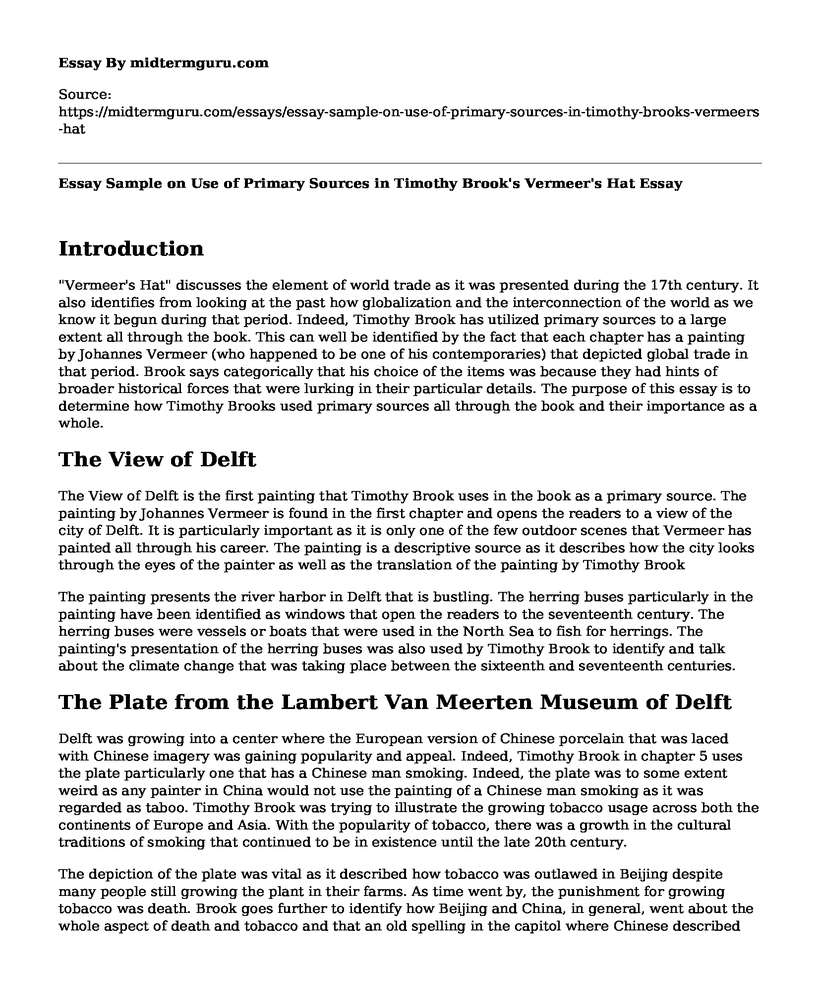Introduction
"Vermeer's Hat" discusses the element of world trade as it was presented during the 17th century. It also identifies from looking at the past how globalization and the interconnection of the world as we know it begun during that period. Indeed, Timothy Brook has utilized primary sources to a large extent all through the book. This can well be identified by the fact that each chapter has a painting by Johannes Vermeer (who happened to be one of his contemporaries) that depicted global trade in that period. Brook says categorically that his choice of the items was because they had hints of broader historical forces that were lurking in their particular details. The purpose of this essay is to determine how Timothy Brooks used primary sources all through the book and their importance as a whole.
The View of Delft
The View of Delft is the first painting that Timothy Brook uses in the book as a primary source. The painting by Johannes Vermeer is found in the first chapter and opens the readers to a view of the city of Delft. It is particularly important as it is only one of the few outdoor scenes that Vermeer has painted all through his career. The painting is a descriptive source as it describes how the city looks through the eyes of the painter as well as the translation of the painting by Timothy Brook
The painting presents the river harbor in Delft that is bustling. The herring buses particularly in the painting have been identified as windows that open the readers to the seventeenth century. The herring buses were vessels or boats that were used in the North Sea to fish for herrings. The painting's presentation of the herring buses was also used by Timothy Brook to identify and talk about the climate change that was taking place between the sixteenth and seventeenth centuries.
The Plate from the Lambert Van Meerten Museum of Delft
Delft was growing into a center where the European version of Chinese porcelain that was laced with Chinese imagery was gaining popularity and appeal. Indeed, Timothy Brook in chapter 5 uses the plate particularly one that has a Chinese man smoking. Indeed, the plate was to some extent weird as any painter in China would not use the painting of a Chinese man smoking as it was regarded as taboo. Timothy Brook was trying to illustrate the growing tobacco usage across both the continents of Europe and Asia. With the popularity of tobacco, there was a growth in the cultural traditions of smoking that continued to be in existence until the late 20th century.
The depiction of the plate was vital as it described how tobacco was outlawed in Beijing despite many people still growing the plant in their farms. As time went by, the punishment for growing tobacco was death. Brook goes further to identify how Beijing and China, in general, went about the whole aspect of death and tobacco and that an old spelling in the capitol where Chinese described smokers as "Chi yan" or smoke eaters. Indeed, tobacco seemed to be at the center of a growing disconnect in Beijing's seat of power. The plate can be viewed at the Lambert Van Meerten Museum of Delft which is a cool aspect.
The Story of the Nostra Sehora da Guia
It is the story of the Portuguese shipwreck that had with it a lot of symbols that were important for the story. Timothy Brook uses the story to depict the globalization that Christianity and religion had and how the encounter brought with it newfound cultures such as drinking of tea in Europe. The shipwreck was from a ship called Nose Senhora da Guia whose voyage was from Manila to Macao. Spanish Jesuit Adriano de las Cortes boarded the ship on February 1625 with the aim of exchanging silver for silk as was the common element of trade with China. The profits from engaging in the trade were used to support missionary activities in Manila. The ship was intercultural and global as it had people from all corners of the world. The ship had with it the Portuguese, the Indians, the Japanese, the Dutch, the Moors, the Jews, and the Africans. The ship got stranded on the Chinese coast near Fujian. Although it was a tragic tale that ended with the killing of many of the people found in the Chinese coast due to mistrust, it helped give an image of the seventeenth century and is an important part of the read. It is a descriptive piece as it describes what happens although it could as well be prescriptive as the nature of the Chinese shows a crude behavior that the reader should well keep away.
Conclusion
In conclusion, we can clearly see how Timothy Brook's used primary sources in many parts of the book. Indeed, this is evidenced by the title as it describes the work of Johannes Vermeer who features prominently in the book. The many primary sources are doorways into the past and tell us the story in a way that a reader is able to relate and feel a part of the entire journey and message as intended by the writer.
Cite this page
Essay Sample on Use of Primary Sources in Timothy Brook's Vermeer's Hat. (2022, Oct 14). Retrieved from https://midtermguru.com/essays/essay-sample-on-use-of-primary-sources-in-timothy-brooks-vermeers-hat
If you are the original author of this essay and no longer wish to have it published on the midtermguru.com website, please click below to request its removal:
- Review Essay on A Rose for Emily
- Essay on The Flesh and the Spirit by Anne Bradstreet
- The Love Song of J. Alfred Prufrock by T. S. Eliot - Literary Analysis Essay
- Literature Analysis Essay on Hamlet and Othello
- Essay Sample on Dante and Eliot Literature
- Literary Analysis Essay on "The Cask of Amontillado" by Edgar Allan Poe
- Character Analysis of Pearl In The Scarlet Letter By Nathaniel Hawthorne







